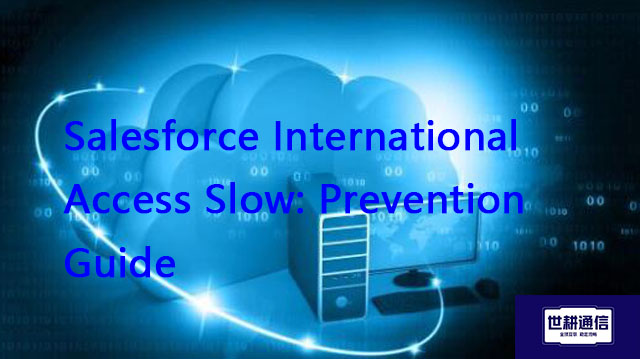Salesforce International Access Slow: Prevention Guide??? Solution//Global IPLC service provider of Shigeng Communication
一、When using Salesforce across borders, slow page loading, delayed operation response, and timeout error prompts not only dampen user motivation, but also directly affect sales efficiency, customer satisfaction, and critical business processes. Instead of passively responding, it's better to take proactive measures! This guide focuses on the fundamental reasons for slow international access and provides actionable preventive strategies to help you create a smooth global Salesforce experience.
Core prevention strategy: Building a speed first global access architecture
Optimize network paths and transmission efficiency:
Location considerations for instances: When making new purchases or migrations, priority should be given to geographic regions that are close to the majority of user groups (such as Asia Pacific users choosing "Japan" or "Australia" instances). This is the most fundamental optimization.
My Domain+login strategy: Make full use of Salesforce's "My Domain" feature and combine it with clear login URL strategies (such as apac.my. salesforce. com) to guide users to automatically connect to the best access point in their area.
Embrace Salesforce CDN: Ensure that Salesforce CDN (Content Distribution Network) is enabled for your organization. CDN caches static resources (such as images, style sheets, JavaScript) to edge nodes distributed globally, allowing users to directly access them from the nearest node, significantly reducing cross ocean transmission. This is the most fundamental and effective global acceleration tool that Salesforce comes with.
Consider external CDN/accelerators: For extremely high requirements or specific scenarios, third-party global CDN service providers (such as Cloudflare, Akamai) or SD-WAN solutions can be evaluated, which provide more refined traffic routing, compression, and protocol optimization, intelligently selecting the best path to bypass international network congestion points.
Force nearby access: If your Salesforce instance is deployed in a specific region (such as North America) and the user is in Asia, cross ocean access will inevitably have high latency. Prevention key:
Compression and Simplification: Ensure that GZIP compression is enabled in Salesforce settings (usually by default) to significantly reduce data transfer volume. Encourage users to use compressed formats (such as ZIP) when uploading files.
Refine Salesforce configuration and data:
Focus on key data: avoid creating reports that return massive amounts of data. Use precise filtering criteria, time ranges, and grouping criteria to limit the number of rows returned.
Asynchronous running and subscription: For time-consuming reports, encourage users to use "asynchronous running" or set subscriptions to avoid waiting on the interface.
Decomposing a giant dashboard: A single dashboard containing too many components (especially charts) can slow down loading. Split into multiple dashboards with clear themes.
Limiting the number of fields: The number of fields displayed in list views, search results, and related lists is a performance killer. Strictly follow best practices and only display absolutely necessary fields (usually recommended not to exceed 20-25).
Be cautious with complex formulas and search fields: Complex formula fields and cross object search fields in list views can significantly increase query load. Assess its necessity and consider using reports as a substitute or asynchronous computation.
View and List View Optimization:
Report and dashboard slimming:
Code and automation review: Regularly audit Apex triggers, batch processing, and streams. Optimize inefficient queries (avoid querying SOQL within loops) and logic to ensure efficiency when processing large amounts of data in batch operations. Avoid synchronously calling time-consuming external services.
Data archiving and cleaning: Regularly archive or delete expired and useless data. A large database will slow down all queries and operations. Establish a data lifecycle management strategy using Salesforce's data archiving tools or third-party solutions.
Standardize user behavior and access methods:
Clear education: Train global users to understand the impact of network distance and emphasize the importance of optimizing practices (such as efficiently using filters, avoiding opening unnecessary tabs, and logging out of idle sessions in a timely manner).
Promote official client: Strongly recommend users to use Salesforce Mobile App (iOS/Android) or Lightning desktop client. These native clients typically have more performance optimizations than pure browser access, especially being more mobile network friendly.
User Training and Best Practices:
Browser selection and management: It is recommended that users use the latest versions of Chrome, Firefox, or Edge (Chromium kernel). Regularly clear browser cache Cookie。 Disable or remove unnecessary and resource consuming browser plugins.
Manage concurrency and sessions: Monitor user concurrency. Implement a reasonable session timeout strategy (while balancing security and user experience). Encourage users to close unused Salesforce tabs.
Manage third-party dependencies:
Assess integration impact: Carefully review all third-party applications (AppExchange applications or custom integrations) integrated with Salesforce. Evaluate its server location, API call frequency, and efficiency. Poor geographical distribution or inefficient integration can become a bottleneck for international access.
Optimize integration mode: Adopt asynchronous integration and batch processing as much as possible to avoid synchronous external calls on the critical path of user operations. Use platform event or change data capture for more efficient data synchronization.
External content/CDN: If your Lightning page, community, etc. contain references to external resources (images, scripts, styles), ensure that these resources are also distributed through a global CDN.
Monitoring and Continuous Improvement:
Ping [Your My Domain]: Test basic connectivity and latency.
Traceroute [Your My Domain]: View network paths and identify nodes with high hop latency (may require IT assistance for interpretation).
Salesforce Trust Status: First time access when there is a widespread slowdown https://status.salesforce.com/ Check the instance status and known issues.
Using Salesforce tools: Regularly check the "Performance Check" results in "Settings". Use Lightning Component Analyzer to check component performance. Monitor API usage restrictions.
Network diagnostic tool: Educate key users (such as administrators) to use basic tools when encountering problems:
User feedback loop: Establish smooth channels to encourage global users to report speed experience issues, especially slow situations in specific operations or regions. Regularly collect feedback for targeted optimization.
Performance testing: Simulate different regional users for performance testing before and after major changes (such as large-scale data migration, new application launch, complex automation deployment) (using tools or real user sampling).
Case study inspiration: prevention first, significant effect
A certain Asia Pacific medical device company: migrating instances of its main users (Japanese and Australian teams) from North America to the "Japan" region, while enabling Salesforce CDN and optimizing key list views (halving the number of fields). Result: The average page loading time has been reduced by over 40%, and user satisfaction has significantly increased.
A European multinational consulting company: Mandatory training on "efficient use of Salesforce" for global sales teams, promoted the use of Salesforce Mobile App, and cleaned up historical activity data for more than three years. Result: Mobile access speed significantly improved, with an average reduction of 35% in the running time of large reports.
Summary: Speed is competitiveness
In the globalized business environment, Salesforce's access speed directly affects the operational efficiency and employee experience of the enterprise. By taking proactive preventive measures in instance location, network optimization (CDN), configuration simplification (view/report), user habit guidance, third-party integrated management, and continuous monitoring, you can significantly reduce the risk of international access latency and provide a fast, reliable, and efficient Salesforce platform for teams distributed around the world. Remember, optimizing speed is not a one-time project, but a journey that requires continuous attention and iteration.

二、Shigeng Communication Global Office Network Products:
The global office network product of Shigeng Communication is a high-quality product developed by the company for Chinese and foreign enterprise customers to access the application data transmission internet of overseas enterprises by making full use of its own network coverage and network management advantages.
Features of Global Application Network Products for Multinational Enterprises:
1. Quickly access global Internet cloud platform resources
2. Stable and low latency global cloud based video conferencing
3. Convenient and fast use of Internet resource sharing cloud platform (OA/ERP/cloud storage and other applications
Product tariff:
Global office network expenses | Monthly rent payment/yuan | Annual payment/yuan | Remarks |
Quality Package 1 | 1000 | 10800 | Free testing experience for 7 days |
Quality Package 2 | 1500 | 14400 | Free testing experience for 7 days |
Dedicated line package | 2400 | 19200 | Free testing experience for 7 days |






